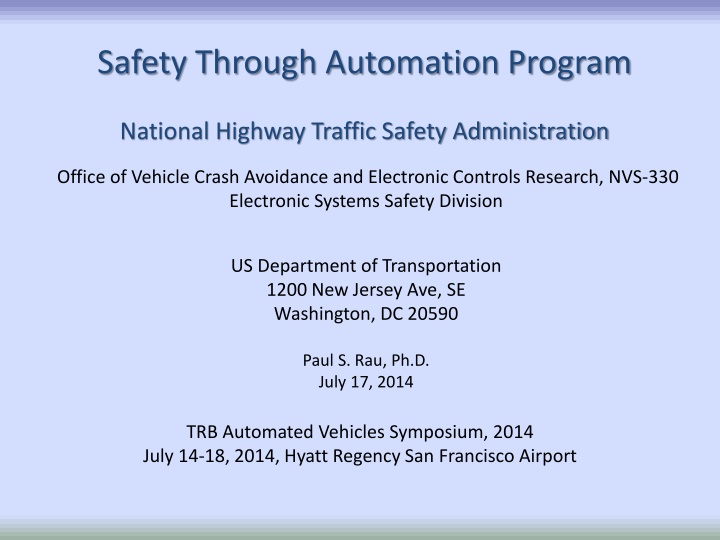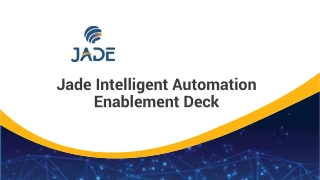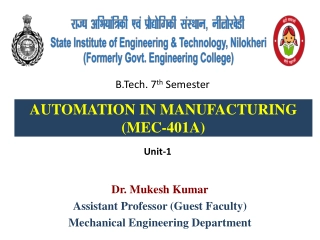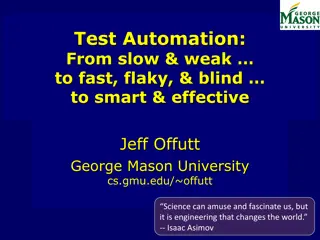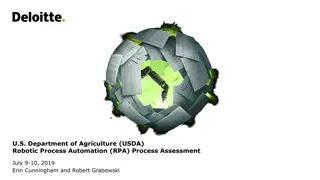Safety Through Automation Program Goals
The Safety Through Automation Program aims to improve motor vehicle safety by defining requirements for automation-assisted driving. It focuses on functionality, reliability, security, precision, driver compatibility, operation intuitiveness, and driver awareness under diverse conditions.
Download Presentation

Please find below an Image/Link to download the presentation.
The content on the website is provided AS IS for your information and personal use only. It may not be sold, licensed, or shared on other websites without obtaining consent from the author.If you encounter any issues during the download, it is possible that the publisher has removed the file from their server.
You are allowed to download the files provided on this website for personal or commercial use, subject to the condition that they are used lawfully. All files are the property of their respective owners.
The content on the website is provided AS IS for your information and personal use only. It may not be sold, licensed, or shared on other websites without obtaining consent from the author.
E N D
Presentation Transcript
Safety Through Automation Program National Highway Traffic Safety Administration Office of Vehicle Crash Avoidance and Electronic Controls Research, NVS-330 Electronic Systems Safety Division US Department of Transportation 1200 New Jersey Ave, SE Washington, DC 20590 Paul S. Rau, Ph.D. July 17, 2014 TRB Automated Vehicles Symposium, 2014 July 14-18, 2014, Hyatt Regency San Francisco Airport
Major Goals Improve motor vehicle safety by defining the requirements for automation assisted driving that is: Functionally safe and electronically reliable. Secure from malicious external control and tampering. Precise in vehicle steering, braking, and acceleration. Compatible with driver abilities and expectations. Operationally intuitive for drivers under diverse driving conditions. Supportive of improving driver awareness in traffic. Operational only to the extent granted by the driver. 2
NHTSAs Preliminary Statement of Policy Concerning Automated Vehicles- 30 May, 2013 Highlights the potential benefits of vehicle automation. Describes NHTSA s safety role on automation and the levels of automation that NHTSA uses for ease of discussion and analysis. Explains our research plan for automated vehicles. Offers recommendations for states that are developing laws related to self-driving vehicles - pertaining only to levels 3 and 4 automation. 3
Conceptual Framework Levels of Automated Driving Level 1 Level 2 Level 3 Level 0 Level 4 Function Specific Automation Combined Function Automation Limited Self Driving Automation Full Self Driving Automation No Automation Braking/throttle and/or steering control, but not designed to work in combination to enable hands free/foot off pedal operation. e.g., automatic braking systems, lane keeping systems. Integration of braking, throttle, and steering control designed to enable hands free/foot off operation . Driver available at all times to retake control. Integration of braking, throttle, and steering control. Driver expected for occasional control. Driver can cede full monitoring and control authority. No steering or braking/ throttle control. e.g., crash warning systems, including V2V applications. Integration of braking, throttle and steering control. Driver NOT expected for control. Responsibility for safe operation is solely rests with the vehicle.
Motor Vehicle Automation Research Roadmap Efforts 1 2 3 4 5 6 Program Planning/ Knowledge Base Develop System Performance Requirements Address Electronic Control Systems Safety Improve Driver Awareness & Response Early Policy Exploration Evaluate System Operability Develop objective tests Reliability and Cybersecurity requirements Performance requirements for automation levels and associated system concepts Perform literature reviews, hold workshops and research critical issues Display & control interface criteria and guidelines Complete human factors studies to evaluate emerging concepts Define safety metrics Complete Evaluation studies Driver Training & Licensing requirements Synthesize findings into a program plan Estimate Benefits 4
Key Areas of NHTSAs Automation Research Human Factors Research Human factors evaluation of Level 2 and Level 3 automated driving concepts Initial human factors design principles for L2/L3 Electronic Control Systems Safety (including Cybersecurity) Functional safety of safety-critical automotive systems and extensions to L2-L4 Cybersecurity threats, vulnerabilities, countermeasure assessment System Performance Requirements System performance requirements framework Objective test procedures Benefits Assessment Target crash population estimation for automated vehicles L2-L4 Multi-modal benefits framework development Testing and Evaluation Controlled test track studies Field operational tests
Human Factors Research Activity Update Human Factors Evaluation of Level 2 and Level 3 Automated Driving Concepts Project Summary: This initial policy study addresses human factors research questions focused on drivers transitioning into and out of automated driving states enabled by Level 2 and Level 3 automated driving concepts. Contractors: VTTI (PI); with Battelle, Bishop Consulting, GM, Google, and SwRI. Project Duration. Oct. 2012 to Nov. 2014 End Products: Human factors principles for the timing, sequence, and presentation elements of the driver interface; Definition of safe conditions for L2 and L3 operation. NHTSA Task Manager: Paul Rau
Electronic Control System Research Activity Update Functional Safety of Automated Lane Centering Controls Project Summary: Lane centering is an essential function that enables vehicle automation when integrated with longitudinal vehicle control systems. It is implemented through shared braking and steering services in combination with longitudinal control systems including adaptive cruise control, crash- imminent braking, and forward collision avoidance. This project investigates functional safety of this emerging technology. Contractor: Volpe Center Project Duration. 21 months from award (July 2014). End Products: This project will produce functional safety assessment of emerging lateral control system(s) that can enable automated operations for Levels 2 to 4 automated vehicles; Hazard analysis report; Draft functional safety requirements; and Draft driver-vehicle interface requirements. NHTSA Task Manager: Paul Rau
System Performance Research Activity Update Automated Vehicle Research for Enhanced Safety Project Summary: Crash Avoidance Metrics Partnership (CAMP) to establish a short, mid and long-term list of emerging automated vehicle applications, and associated functional descriptions, operational concepts, and draft objective test procedures to inform Automation Program Plan activities. Contractor: (Cooperative Agreement with) CAMP Project Duration. Oct 2013 Sep 2015 End Products: Detailed Functional Descriptions for Automated Vehicles for L2- L4; Concept Roadmaps for future Automation Applications; Use Cases; Top- level safety requirements; Preliminary objective test methods; Final Report. NHTSA Task Manager: Frank Barickman
Benefits Research Activity Update Target Crash Populations for Automated Vehicles Project Summary: Preliminary analyses to estimate the potential crash populations that can be addressed by the deployment of concept automation technologies. Contractor: Volpe Center Project Duration. 12 months from award (July 2014). End Products: Method for estimating target crash populations addressable with automated vehicle technology & concepts; Development of a base estimation model for the subsequent integration of effectiveness data from emerging system concepts, system performance testing, naturalistic studies, early adopter evaluations, to establish safety benefits. NHTSA Task Manager: Paul Rau
